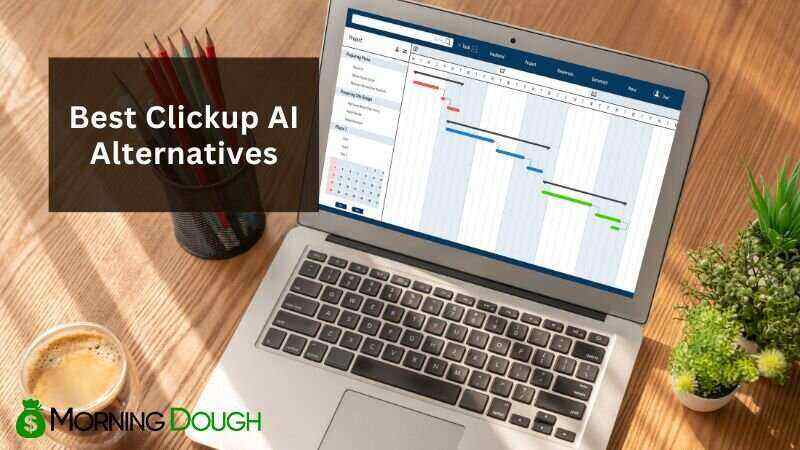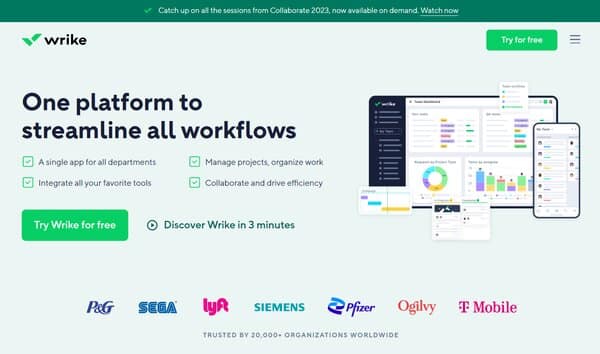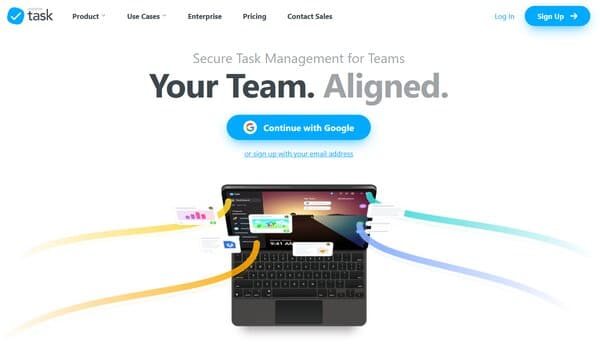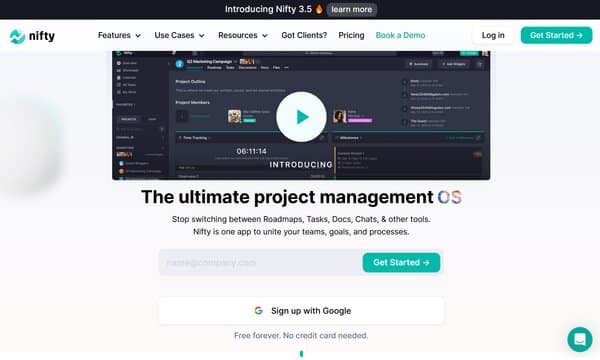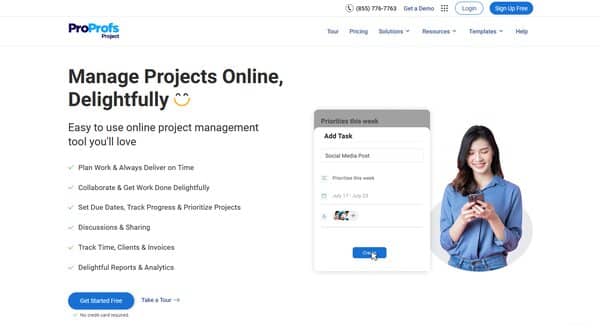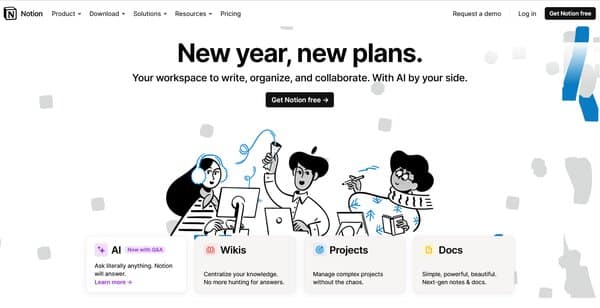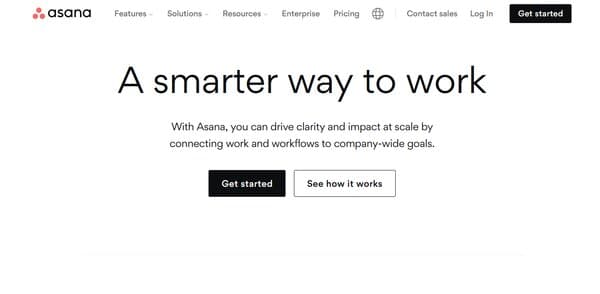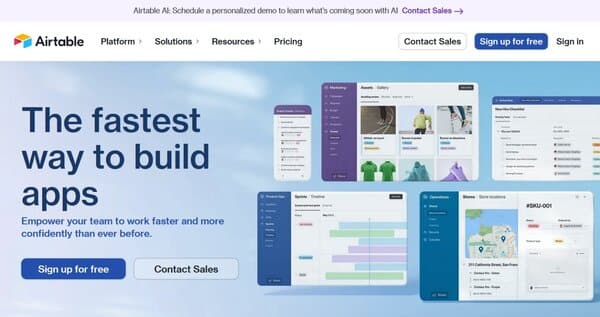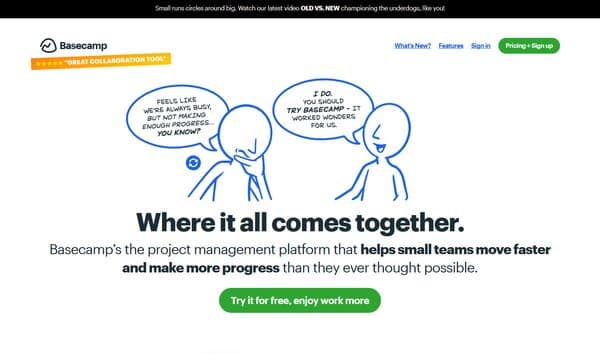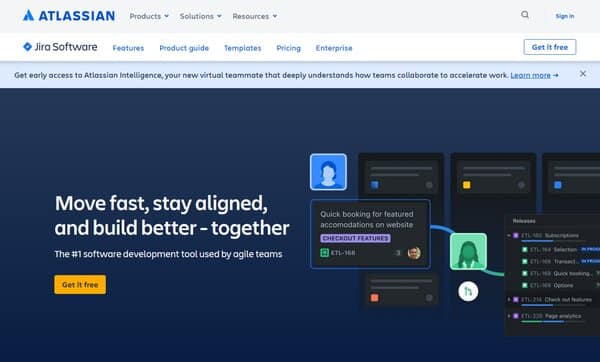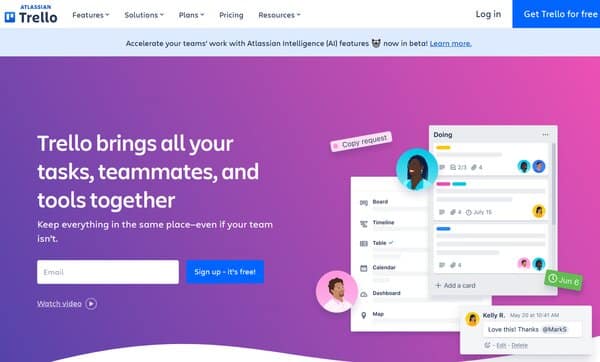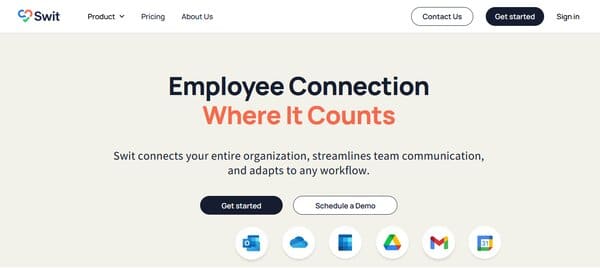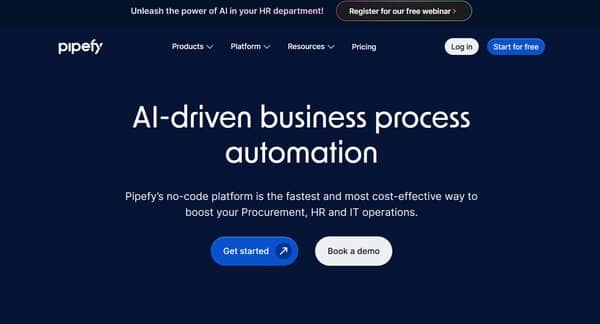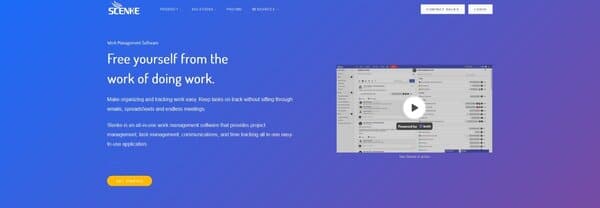15 Best Clickup AI Alternatives
In the ever-evolving world of project management and productivity tools, the need for efficient, user-friendly, and AI-powered solutions is more pressing than ever. One such tool that has gained significant traction is ClickUp, known for its robust features and AI capabilities. However, as with any tool, it may not be the perfect fit for everyone. This is where ClickUp AI alternatives come into play. These alternatives offer similar, and in some cases, more advanced features that cater to different needs and preferences.
The search for the best ClickUp AI alternatives is not just about finding a tool with similar features. It’s about discovering a solution that aligns with your specific needs, enhances your productivity, and ultimately, propels your business forward. Whether you’re a small business owner, a project manager, or a team leader, exploring ClickUp AI alternatives can open up new avenues for efficiency and innovation.
The Need for Clickup AI Alternatives
The need for ClickUp AI alternatives arises from various factors. While ClickUp is a comprehensive tool, it may not cater to everyone’s specific needs. Some users might find the platform too complex to navigate, or they might require features that ClickUp doesn’t offer. Additionally, the AI capabilities of ClickUp, while impressive, might not be as extensive or as customizable as some users would prefer.
Moreover, every business has unique requirements and workflows. What works for one might not work for another. Therefore, having alternatives means you can find a tool that fits your business like a glove. ClickUp AI alternatives offer a range of features, from advanced AI capabilities to user-friendly interfaces and extensive customization options. By exploring these alternatives, you can find a tool that not only matches but enhances your workflow.
ClickUp
ClickUp is a comprehensive project management and productivity tool designed to streamline team collaboration and work management. It offers a unified platform where teams can plan, organize, and collaborate on projects, ensuring that tasks are completed efficiently and on time. ClickUp is known for its versatility, offering features that cater to a wide range of industries and team sizes, from startups to large enterprises. It’s a tool that adapts to your workflow, rather than forcing you to adapt to it.
What does ClickUp do?
ClickUp serves as a central hub for all your work and project management needs. It allows you to create tasks, assign them to team members, set deadlines, and track progress all in one place. ClickUp also integrates with a variety of other tools, making it easier to consolidate your work. It offers features like document sharing, time tracking, goal setting, and reporting, which provide a holistic view of your projects and team performance. With ClickUp, you can streamline your workflow, improve team collaboration, and increase productivity.
ClickUp Key Features
Task Management: ClickUp’s task management feature allows you to create, assign, and track tasks. You can set priorities, deadlines, and dependencies, ensuring that your team stays on track and meets project deadlines.
Time Tracking: With ClickUp’s time tracking feature, you can monitor how much time is spent on each task. This helps in assessing productivity and can be useful for billing purposes if you’re working with clients.
Goal Setting: ClickUp allows you to set and track goals, making it easier to keep your team focused and aligned with the company’s objectives.
Reporting: ClickUp’s reporting feature provides insights into your team’s performance and project progress. You can generate various reports to analyze data and make informed decisions.
Integration: ClickUp integrates with a variety of other tools, allowing you to consolidate your work in one place. This reduces the need to switch between different apps, saving time and improving efficiency.
Document Sharing*: ClickUp allows you to share documents within the platform, making collaboration easier. Team members can access, edit, and comment on documents, facilitating better communication and teamwork.
ClickUp Pricing Plans
ClickUp offers four different pricing plans to cater to various needs and budgets.
Free Plan: The Free Plan is best for personal use. It offers basic features and is free forever.
Unlimited Plan: The Unlimited Plan is designed for small teams and costs $7 per member per month. It includes everything in the Free Plan and more, providing additional features to enhance productivity and collaboration.
Business Plan: The Business Plan is ideal for mid-sized teams and costs $12 per member per month. It includes everything in the Unlimited Plan and offers additional features tailored for business needs.
Enterprise Plan: The Enterprise Plan is designed for large teams and includes everything in the Business Plan. The pricing for this plan is not publicly listed and interested users are advised to contact ClickUp for a quote.
ClickUp accepts debit and credit cards, PayPal, and bank wire transfer for payments.
15 Best Clickup AI Alternatives
- Wrike
- Meister Task
- Flow
- Nifty
- Proprofs Project
- Notion
- Asana
- Airtable
- Basecamp
- Hive
- Jira
- Trello
- Swit
- Pipefy
- Slenke
How to choose the Best Clickup AI Alternatives?
Choosing the best ClickUp AI alternatives involves careful consideration of several factors. First, you need to clearly define your needs. What features are you looking for? Do you need advanced AI capabilities, or are you more interested in user-friendly interfaces and easy navigation?
Consider the tool’s ease of use and learning curve. A tool with a steep learning curve might slow down your team’s productivity. Look for a tool that is intuitive and easy to navigate. Also, consider the tool’s collaboration features. Effective collaboration is key in a team environment, so look for features like real-time chat and comments.
Finally, consider the tool’s customization options. The ability to tailor the tool to your specific needs can greatly enhance your productivity. Whether it’s custom views, workflows, or integrations, having the ability to customize your tool can make a significant difference in your team’s efficiency.
Clickup AI Alternatives (Free and Paid)
1. Wrike
Wrike stands out as a versatile project management tool designed to cater to the needs of various teams and organizations. It offers a robust platform that allows users to adapt workflows, change views, and tailor workspaces to align with team preferences while ensuring comprehensive visibility. The software aims to eliminate inefficiencies by automating routine tasks, creating automatic approvals, request forms, and repeatable blueprints, enabling teams to concentrate on their most valuable work. Wrike is built to help businesses deliver outcomes faster by streamlining processes and enhancing productivity, taking it to the tip of the Clickup AI alternatives list.
What does Wrike do?
Wrike is a comprehensive work management solution that facilitates project planning, tracking, and collaboration across teams. It provides a centralized platform where tasks, discussions, and emails are connected to the project plan, promoting transparency and efficiency. Wrike is optimized for agile workflows and is designed to resolve issues related to data silos, poor visibility into work status, and missed deadlines. With its ability to integrate with over 400 applications, Wrike ensures that teams can work seamlessly with the tools they are already using, further boosting productivity and efficiency.
Wrike Key Features
Customizable Workflows: Wrike allows users to create custom workflows that match their team’s unique processes, enabling them to work more efficiently and effectively.
Real-Time Collaboration: Teams can collaborate in real-time within the platform, ensuring that everyone is on the same page and can make informed decisions quickly.
Integrations: With over 400 integrations, Wrike connects with other tools like Salesforce, Hubspot, and Slack, centralizing work and reducing the need to switch between applications.
Generative AI: Wrike’s Generative AI feature can generate detailed project plans and documents, transforming productivity by automating content creation.
Advanced Reporting: The platform offers advanced reporting tools that provide insights into project performance, helping teams to track progress and make data-driven decisions.
Security and Compliance: Wrike takes security seriously, offering robust data protection, access controls, and compliance with industry standards to ensure that sensitive information is safeguarded.
Wrike Pros and Cons
Wrike Pros
- Customizable workflows
- Real-time collaboration
- Extensive integrations
- Generative AI capabilities
- Advanced reporting tools
- Strong security features
Wrike Cons
- Limited free plan functionality
- Requires internet connectivity
Wrike Pricing Plans
Wrike offers a variety of pricing plans to accommodate the needs of different teams and organizations.
Free Plan: Aimed at teams just getting started, this plan includes basic task management features, board view, and AI content generation.
Team Plan: Designed for smaller teams, this plan, priced at $9.80 per user per month, offers full project planning and collaboration tools, with pricing available on the Wrike website.
Business Plan: Tailored for mid-sized teams and priced at $24.80 per user per month, it includes advanced reporting and automation capabilities, with specific pricing details provided by Wrike.
Enterprise Plan: Suitable for large organizations requiring enterprise-grade security and scalability, with custom pricing based on the company’s needs.
Pinnacle Plan: The most comprehensive plan, offering the full suite of Wrike features for businesses that need the highest level of functionality and support.
Payment options include debit and credit cards, PayPal, and bank wire transfers.
2. Meister Task
Meister Task is a comprehensive task management and collaboration tool designed to streamline workflows and enhance team productivity. With its intuitive and customizable environment, Meister Task offers a visually appealing platform that adapts to any team’s workflow, making it suitable for managing everything from software sprints to editorial calendars. It goes beyond merely visualizing work by automating recurring steps in users’ workflows, thereby increasing efficiency and consistency.
What does Meister Task do?
Meister Task serves as a central hub for task management, allowing teams to create, assign, and track tasks in a unified space. It offers a customizable dashboard that includes a personal checklist, notifications, and time tracking information. The platform’s Kanban-style boards provide a clear overview of tasks and optimize workflows. Meister Task also facilitates communication among team members, allowing them to comment, reply, or react to updates in the activity stream. This Clickup AI alternative also integrates with other apps like MindMeister, Slack, Google, MS Teams, Zendesk, GitHub, and many more, ensuring smooth, productive workdays.
Meister Task Key Features
Task Management: Meister Task offers robust task management features, including task creation, assignment, and prioritization. It allows users to organize their tasks, track their progress, and ensure timely completion.
Automations: Meister Task can automate recurring steps in your workflow, increasing efficiency and consistency.
Communication Features: The platform facilitates communication among team members, allowing them to comment, reply, or react to updates in the activity stream.
Integrations: Meister Task integrates with your favorite apps like MindMeister, Slack, Google, MS Teams, Zendesk, GitHub, and many more, ensuring smooth, productive workdays.
Customizable Dashboard: Your customizable dashboard includes a personal checklist, notifications, and time tracking information.
Kanban-style Boards: Keep an overview of tasks and optimize workflows on Kanban-style boards: from to-do, to doing, to done.
Meister Task Pros and Cons
Meister Task Pros
- Easy to use
- Robust task management features
- Effective communication tools
- Useful integrations
- Customizable dashboard
- Kanban-style boards
Meister Task Cons
- Limited basic plan
- Internet connection is required
Meister Task Pricing Plans
Meister Task offers four pricing plans to cater to different user needs.
Basic Plan: This plan is free and offers core task management features for single users.
Pro Plan: Priced at $13.50 per user per month ($11 per user per month when billed annually), this plan offers collaborative task management for teams, including unlimited projects, recurring tasks, and more.
Business Plan: Priced at $27.00 per user per month ($22.50 per user per month when billed annually), this plan is suitable for larger organizations requiring advanced collaboration and customization features.
Enterprise Plan: This plan offers custom pricing and is designed for large enterprises with specific needs and requirements.
Meister Task accepts debit and credit cards, and bank wire transfer for payments.
3. Flow
Flow is a modern task and project management software designed to bring together tasks, projects, timelines, and conversations, all in one place. It’s a tool that has been embraced by thousands of businesses worldwide, helping them streamline their operations and improve productivity. Flow is known for its intuitive interface and robust features, making it a popular choice among teams looking for a comprehensive solution to manage their work, making it one of the best Clickup AI alternatives.
What does Flow do?
Flow is designed to help teams coordinate their work more effectively. It allows users to create tasks, set priorities, organize tasks into lists, track task histories, and set repeating tasks. It also offers features for sorting tasks by person, keyword, due date, or tag. Flow is more than just a task management tool; it’s a platform that facilitates collaboration and communication within teams. It integrates with your favorite tools, making it easier to manage projects and tasks in one place. Whether you’re a small team or a large organization, Flow can help you stay organized, focused, and meet your deadlines.
Flow Key Features
Task and Project Management: Flow allows users to create, assign, and track tasks and projects. It offers features like task histories, comments, attachments, and the ability to set repeating tasks.
Collaboration Tools: Flow facilitates team collaboration by providing a platform where tasks, projects, timelines, and conversations can be brought together. It helps teams stay connected and work together more effectively.
Integration with Other Tools: Flow integrates with your favorite tools, making it easier to manage your tasks and projects without having to switch between different platforms.
User-Friendly Interface: Flow is known for its intuitive and user-friendly interface. It’s easy to learn and use, making it a popular choice among teams of all sizes.
Flexible and Customizable: Flow is flexible and customizable, allowing teams to tailor the platform to their specific needs. It offers different viewing modes in projects to see tasks in list, kanboard board, and more.
Advanced Security: Flow offers advanced security features, ensuring that your data is safe and secure.
Flow Pros and Cons
Flow Pros
- Intuitive and user-friendly interface
- Robust task and project management features
- Effective collaboration tools
- Integrates with other popular tools
- Flexible and customizable
Flow Cons
- No free plan is available
- Internet connection is required
Flow Pricing Plans
Flow offers three different pricing plans to cater to the varying needs of teams and businesses.
Basic Plan: The Basic Plan, priced at $8 per user per month ($6 per user per month), offers all essential features, some basic integrations, and great security and support. It is priced at $6 per user, per month.
Plus Plan: The Plus Plan, priced at $12 per user per month ($8 per user per month), includes everything in the Basic Plan, along with advanced features, more control and insights, all basic integrations, and API access.
Pro Plan: The Pro Plan, priced at $18 per user per month ($10 per user per month), includes everything in the Plus Plan, along with advanced security, access management, all integrations (including Zapier), and VIP Support.
Flow accepts debit and credit cards, and bank wire transfer for payments.
4. Nifty
Nifty positions itself as a dynamic project management tool designed to streamline operations and foster team collaboration. It offers a centralized platform where all phases of a project’s lifecycle can be managed with ease. The platform is celebrated for its user-friendly interface and its ability to integrate with a multitude of third-party applications, ensuring that teams can work within a unified ecosystem without the need to constantly switch between different tools. Nifty’s versatility makes it a suitable choice for a wide array of client environments, from marketing teams to development squads, enhancing overall productivity and project oversight.
What does Nifty do?
Nifty is engineered to simplify project management by offering a suite of tools that cater to various aspects of the workflow. It facilitates the creation of project milestones for automated status reporting, which provides clear visualization of project progress. Time tracking features are included to enhance productivity, while project portfolios allow for organized management of multiple initiatives. Nifty also boasts robust reporting capabilities, enabling instant insights that help in workload allocation and balance. The platform’s comprehensive approach integrates tasks, docs, chats, and other tools, thereby optimizing team productivity and goal achievement.
Nifty Key Features
Custom if/then Automations: Nifty’s automation capabilities allow users to set up custom if/then rules, which can automate repetitive tasks and save valuable time.
Custom Embeds: The platform supports embedding thousands of third-party apps and websites, which can be integrated across projects, tasks, and documents.
Project Milestones: Nifty enables automated status reporting through project milestones, offering a clear visualization of progress.
Time Tracking: The inclusion of time tracking tools helps teams monitor productivity and improve time management.
Project Portfolios: Users can organize projects into portfolios, which aids in managing multiple projects simultaneously and efficiently.
Robust Reporting: Nifty provides powerful reporting tools that deliver automated insights, facilitating quick decision-making and workload management.
Nifty Pros and Cons
Nifty Pros
- User-friendly interface
- Versatile project management
- Integrated roadmaps and tasks
- Unified communication tools
- Automated insights and reporting
- Scalable for various team sizes
Nifty Cons
- Limited free plan
- Some features may have a learning curve
Nifty Pricing Plans
Nifty offers a range of pricing plans to accommodate different team sizes and needs.
Free Plan: This plan is ideal for getting started at no cost, offering 100 MB of storage and unlimited members.
Starter Plan: At $49 per member per month ($39 per member per month when billed annually), this plan includes all core features with 100 GB of storage.
Pro Plan: For more advanced needs, the Pro Plan, priced at $99 per member per month ($79 per member per month when billed annually), includes additional features like time tracking and reporting.
Business Plan: Aimed at larger teams, this plan, priced at $149 per member per month ($124 per member per month when billed annually), offers extensive storage and active project management capabilities.
Unlimited Plan: For enterprises requiring unlimited resources, this plan is available at $499 per member per month ($399 per member per month when billed annually).
Nifty accepts various payment methods, including debit and credit cards, and PayPal.
5. Proprofs Project
Proprofs Project stands out as a versatile project management tool designed to streamline workflow and enhance team collaboration. It offers a suite of features that cater to various aspects of project management, from planning to execution and reporting. The platform is engineered to simplify complex project tasks, making it easier for teams to meet deadlines and manage resources effectively. With its user-friendly interface, Proprofs Project aims to provide a seamless experience for managing projects of all sizes, ensuring that teams can focus on delivering quality work without getting bogged down by the intricacies of project management.
What does Proprofs Project do?
Proprofs Project is a comprehensive solution for managing projects that facilitates better planning, tracking, and collaboration. It enables teams to create and assign tasks, set deadlines, and monitor progress through intuitive dashboards. The software’s robust reporting capabilities allow for the generation of detailed reports, including project status, task breakdowns, and financial summaries. With features like Gantt charts for visual project timelines and the ability to share reports securely with stakeholders, Proprofs Project ensures that every aspect of a project is transparent and on track for successful completion.
Proprofs Project Key Features
Customizable Dashboards: Tailor your project dashboard to show the information most relevant to you, ensuring quick access to critical data.
Gantt Charts: Visualize your project timeline and dependencies, making it easier to plan and adjust as needed.
Time Tracking: Keep accurate records of time spent on tasks, which is essential for billing and productivity analysis.
Collaborative Workspaces: Enable team members to work together efficiently, regardless of their location, with shared spaces for communication and task management.
Comprehensive Reporting: Generate detailed reports to gain insights into project performance, financials, and task completion.
Secure Sharing: Share project reports and updates with stakeholders through secure URLs, maintaining confidentiality and control over your data.
Proprofs Project Pros and Cons
Proprofs Project Pros
- User-friendly interface
- Robust reporting tools
- Visual project planning
- Effective time tracking
- Secure data sharing
- Collaborative features
Proprofs Project Cons
- Limited customization
- Potential cost for small teams
Proprofs Project Pricing Plans
Proprofs Project offers one plan with 2 payments options. Priced at $49.97 per month ($39.97 per month when billed annually), includes features such as calendars, list views, Kanban boards, Gantt charts, time tracking, invoicing, and more. It’s designed for teams that prefer a short-term commitment with the flexibility to scale up or down as needed.
Both plans support various payment methods, including debit and credit cards, PayPal, and bank wire transfers, ensuring convenience for users worldwide.
6. Notion
Notion is a versatile and comprehensive productivity tool that serves as a unified workspace for teams and individuals. It’s designed to centralize various work processes, including project management, note-taking, and knowledge sharing, into a single, user-friendly platform. Notion’s flexibility allows it to adapt to a wide range of use cases, making it a popular choice for both personal and professional use.
What does Notion do?
Notion is a multi-faceted tool that provides a platform for users to write, plan, and collaborate. It offers a range of features such as notes, tasks, wikis, and databases, which can be customized to suit each user’s specific needs. Notion’s unique block-based system allows users to create custom pages, databases, and workflows, making it a powerful tool for organizing information and managing projects. It’s designed to be intuitive and easy to use, making it accessible to people of all skill levels.
Notion Key Features
Customizable Workspace: Notion’s workspace is highly customizable, allowing users to create pages, databases, and workflows that suit their specific needs. This flexibility makes it a powerful tool for organizing information and managing projects.
Block-Based System: Notion uses a unique block-based system, where each piece of content is a block that can be moved, customized, and arranged in any way the user sees fit. This system allows for a high degree of customization and flexibility in how information is organized and presented.
Collaborative Tools: Notion provides a range of collaborative tools that make it easy for teams to work together. These include shared workspaces, real-time editing, and easy sharing of pages and documents.
Integrated Task Management: Notion includes integrated task management features, allowing users to create, assign, and track tasks within the platform. This makes it a comprehensive solution for project management.
Knowledge Base: Notion serves as a centralized knowledge base, with features like wikis that make it easy to store, organize, and share information. This makes it a valuable tool for teams looking to centralize their knowledge and documentation.
Database Functionality: One of Notion’s most powerful features is its database functionality. Users can create custom databases to store and organize information, with a range of views (like tables, lists, and kanban boards) available to display data.
Notion Pros and Cons
Notion Pros
- Highly customizable
- Integrated task management
- Centralized knowledge base
- Powerful database functionality
- User-friendly interface
Notion Cons
- Can be overwhelming for new users
- Limited free plan
- No offline mode
Notion Pricing Plans
Notion offers four different pricing plans to cater to a variety of user needs.
Free Plan: The Free Plan is perfect for individual use, offering basic features such as unlimited pages and blocks, and file uploads up to 5MB.
Plus Plan: Priced at $8 per month when billed annually, the Plus Plan offers features like unlimited file uploads, version history, and priority support, making it ideal for personal use with more demanding needs.
Business Plan: At $15 per user per month when billed annually, the Business Plan is designed for teams and offers additional features like advanced permissions, admin tools, and unlimited team members.
Enterprise Plan: The Enterprise Plan offers advanced features tailored to large organizations, including SAML SSO, a dedicated manager, and custom contract and invoicing. Pricing for the Enterprise Plan is available upon request.
Notion accepts debit and credit cards, PayPal, and bank wire transfer for payments.
7. Asana
Asana is a robust project management tool designed to help teams organize, track, and manage their work. It’s a comprehensive platform that offers a wide range of features to streamline workflows, enhance collaboration, and improve productivity. Asana is known for its flexibility, allowing teams to customize their workspaces to suit their specific needs. This Clickup AI alternative can be used by businesses of all sizes, from small startups to large corporations, across various industries.
What does Asana do?
Asana provides a centralized platform where teams can plan, manage, and execute their projects. It allows users to create tasks, assign them to team members, set deadlines, and track progress. Asana also offers multiple views, including list, board, and calendar, to visualize work in a way that best suits the team’s needs. It also supports real-time updates and communication, ensuring everyone is on the same page. With over 200 integrations, Asana can connect with other popular work tools, making it a one-stop solution for managing work from start to finish.
Asana Key Features
Task Management: Asana allows users to create, assign, and schedule tasks. It also enables setting priorities and deadlines, ensuring that important tasks are completed on time.
Project Visualization: With multiple views, including list, board, and calendar, Asana provides different ways to visualize projects, making it easier to understand the workflow and track progress.
Real-Time Updates: Asana supports real-time updates, allowing team members to see the latest changes and progress on tasks and projects.
Communication Tools: Asana includes communication tools such as task comments, which enhance team collaboration and promote efficient communication.
Integrations: Asana seamlessly integrates with over 200 apps, including popular ones like Google Drive and Slack, making it even more convenient to manage work.
Asana Intelligence: This feature uses AI to help organizations work smarter, driving greater clarity, impact, and scale.
Asana Pros and Cons
Asana Pros
- Comprehensive task and project management features
- Multiple views for project visualization
- Real-time updates and communication tools
- Extensive integrations
- AI-powered feature for smarter work
Asana Cons
- Steep learning curve for new users
- Advanced features only available in paid plans
Asana Pricing Plans
Asana offers four pricing plans: Personal, Starter, Advanced, and Enterprise.
Personal Plan: This plan is free and aimed at individuals and small teams just getting started with project management. It includes basic task management features and multiple work views.
Starter Plan: The Starter plan costs $10.99 per user per month when billed annually, or $13.49 per user per month when billed monthly. It includes everything in the Personal plan, plus additional features like timeline view, forms, and rules.
Advanced Plan: The Advanced plan costs $24.99 per user per month when billed annually. It includes everything in the Starter plan, plus advanced features like custom fields, start dates, and dependencies.
Enterprise Plan: The Enterprise plan is for companies that need to meet strict compliance requirements with flexible, precise controls. The pricing for this plan is not publicly available and interested users need to contact Asana’s sales team for a quote. This plan includes everything in the Advanced plan, plus additional features like data export, user provisioning and deprovisioning, and priority support.
Asana accepts debit and credit cards for payments.
8. Airtable
Airtable is a versatile platform that empowers teams to streamline their workflows and manage their data more efficiently. It’s a unique blend of a spreadsheet and a database, offering the simplicity of a spreadsheet with the power of a database. Airtable is designed to be flexible and customizable, allowing users to structure and store data in a way that best suits their needs. It’s a tool that can be used across various industries and for a multitude of purposes, from project management to event planning, and from sales tracking to customer relationship management.
What does Airtable do?
Airtable provides a platform where you can organize anything with anyone, anywhere. It allows users to create their own workflows and customize them according to their needs. With real-time data syncing, any changes made are automatically updated across all workflows, eliminating the need for manual updates. Airtable offers a variety of views, including List, Timeline, and Gantt, and it also has an Interface Designer that lets users design custom apps using drag-and-drop elements. It also offers automation features, allowing users to automate repetitive tasks and streamline their workflows.
Airtable Key Features
Real-Time Data Syncing: Airtable syncs data in real time, ensuring that any changes made are automatically updated across all workflows.
Customizable Views: Airtable allows users to transform their data into actionable views, such as List, Timeline, Gantt, and more.
Interface Designer: With Airtable’s Interface Designer, users can design custom apps in minutes using drag-and-drop elements.
Automation Features: Airtable offers automation features that allow users to automate repetitive tasks and streamline their workflows.
Integration Capabilities: Airtable can integrate with almost any tool in your workflow, making it a versatile tool for managing data.
Scalability: Airtable is designed to grow with the needs of your business, making it suitable for both small projects and large-scale business applications.
Airtable Pros and Cons
Airtable Pros
- User-friendly interface
- Real-time data syncing
- Customizable views
- Automation features
- Integration capabilities
Airtable Cons
- Can be overwhelming for new users
- Limited free plan
Airtable Pricing Plans
Airtable offers four different pricing plans to cater to different needs and budgets.
Free Plan: This plan offers basic features for users to get started with Airtable. It includes essential collaboration features and a limited number of automations runs and records.
Team Plan: Priced at $24/user/month when billed annually or $20/user/month when billed monthly, the Team Plan offers additional features such as increased records per base, advanced calendar features, and more customization options.
Business Plan: Priced at $54/user/month when billed annually or $45/user/month when billed monthly, the Business Plan offers even more advanced features and increased limits, designed for small businesses and departments.
Enterprise Scale Plan: This plan is designed for large organizations with extensive needs. It offers the highest limits and the most advanced features. The pricing for this plan is also not publicly listed and interested users are advised to contact Airtable’s sales team for more information.
Airtable accepts debit and credit cards for payments.
9. Basecamp
Basecamp is a comprehensive project management and team communication tool that caters to businesses of all sizes. It offers a unified platform where teams can collaborate, manage tasks, and track project progress. Basecamp is designed to streamline workflows, enhance productivity, and foster effective communication within teams.
What does Basecamp do?
Basecamp provides a centralized platform for project management and team collaboration. It allows teams to create and manage projects, assign tasks, set deadlines, and track progress. Basecamp also offers features for team communication, including private conversations and notifications. It consolidates various functionalities such as chat, file sharing, task management, and basic scheduling into one platform, eliminating the need for multiple separate apps. This results in a more organized and efficient workflow, reducing the chances of losing important information or missing out on updates.
Basecamp Key Features
Unlimited Projects: Basecamp allows for the creation and management of unlimited projects, making it suitable for businesses with multiple ongoing projects.
Private Conversations: The platform offers a feature called ‘pings’ for private conversations, ensuring confidential discussions remain private.
Reports: Basecamp provides reports that summarize essential project details, helping teams stay updated on project progress.
Notification Protections: To prevent constant distractions, Basecamp has notification protections that control the frequency of notifications.
Consolidated Billing: Basecamp helps consolidate billing, reducing administrative tasks and potentially cutting costs.
Simplified Onboarding: The platform simplifies the onboarding process, making it easy for new team members to get started.
Basecamp Pros and Cons
Basecamp Pros
- Comprehensive project management features
- Consolidates multiple functionalities into one platform
- Offers private conversation feature
- Provides detailed reports
- Simplifies onboarding process
Basecamp Cons
- No free plan is available
- Pricing may be high for small teams
Basecamp Pricing Plans
Basecamp offers two main pricing plans:
Basecamp Plan: This plan costs $15 per user per month and includes all core Basecamp features. It is suitable for startups, freelancers, and small teams.
Basecamp Pro Unlimited Plan: This plan is available at a flat rate of $299 per month (when billed annually) and is ideal for large groups or rapidly growing teams. It offers unlimited users and expanded storage.
Basecamp accepts debit and credit cards transfer for payments.
10. Hive
Hive is a robust project management and collaboration tool designed to streamline workflows and enhance productivity within teams. Built on top of the Hadoop ecosystem, Hive provides an SQL-like interface, HiveQL, for querying and analyzing large datasets stored in Hadoop’s distributed storage. It’s designed to cater to the needs of the modern workforce, offering a platform that can be customized to fit unique requirements, whether that involves working from home or the office, or using preferred tools to complete tasks.
What does Hive do?
Hive is a data warehouse infrastructure tool that processes structured data in Hadoop. It resides on top of Hadoop to summarize Big Data, making querying and analyzing large datasets more manageable. Hive is designed for querying and managing only structured data stored in tables. It is scalable, fast, and uses familiar concepts. Hive supports four file formats: ORC, SEQUENCEFILE, RCFILE (Record Columnar File), and TEXTFILE. It is frequently used for data warehousing tasks like data encapsulation, Ad-hoc Queries, and analysis of huge datasets.
Hive Key Features
Task Management: Hive excels in task and sub-task management, including the creation of recurring tasks. This feature allows teams to plan, track, and manage their projects, tasks, and resources effectively.
Team Collaboration: Hive promotes effective teamwork and efficient communication. It offers features like task commenting, assign comments, and the ability to attach important files to tasks.
Data Processing: Hive is capable of processing very large datasets of Petabytes in size. It can easily embed custom MapReduce code to process unstructured data.
Custom Automations: Hive allows for the automation of everyday tasks and syncing of most-used apps. This feature helps to cut down on manual labor and streamline workflows.
Proofing and Review Environment: Hive provides a robust proofing and review environment, which is particularly useful for teams working on content creation and design.
Flexible Work Modes: Hive supports hybrid work modes, allowing team members to work from home or the office, and using the tools they prefer to complete tasks.
Hive Pros and Cons
Hive Pros
- Scalable and fast
- Supports structured data processing
- Robust proofing and review environment
- Customizable for unique requirements
- Supports hybrid work modes
Hive Cons
- No free plan is available
- Requires some learning curve
Hive Pricing Plans
Hive offers 4 pricing plans:
Free Plan: This plan is free forever for teams up to 2 people.
Starter Plan: The Starter Plan offers a comprehensive set of features that promote effective teamwork, streamlined project management, and efficient communication. It costs $5/user/month when paid annually (or $7/user/month when paid monthly) with add-ons available.
Teams Plan: The Teams Plan, priced at $18 per month per user ($16 per month per user when billed annually), is ideal for businesses that implement multiple projects and need enhanced collaboration, organization, and productivity. The pricing for this plan is available upon request.
Enterprise Plan: The Enterprise Plan is perfect for very large organizations and teams that require advanced features and capabilities. Custom pricing plans are available upon request.
Hive accepts debit and credit cards for payments.
11. Jira
Jira, developed by Atlassian, is a leading project management tool designed to facilitate agile workflows and enhance team collaboration. It is widely recognized for its robust features that cater to various teams, including software development, product management, and DevOps teams. Jira’s versatility allows it to adapt to the unique needs of these teams, providing a single source of truth throughout the entire development lifecycle. It is designed to break down big ideas into manageable tasks, making work more visible and collaboration more efficient.
What does Jira do?
Jira is a comprehensive project management tool that enables teams to plan, track, release, and support software with confidence. It is designed to manage simple projects as well as power DevOps practices, making it easy for teams to move work forward, stay aligned, and communicate in context. Jira’s capabilities extend beyond project management, offering issue tracking and task management features that keep teams aligned and focused on their goals. It is a flexible tool that supports any agile project management methodology, be it Scrum, Kanban, or a team’s unique approach.
Jira Key Features
Customizable Workflows: Jira allows teams to create customizable workflows that map to any style of work, providing flexibility and adaptability to different project requirements.
Powerful Agile Boards: Jira offers powerful agile boards, including Scrum and Kanban boards, that help teams visualize their work, limit work-in-progress, and maximize efficiency.
Reports and Insights: Jira provides out-of-the-box reports and dashboards that offer critical insights within the context of the project, helping teams learn and improve.
Project Flexibility: Jira supports project flexibility, allowing teams to start with a simple setup and customize as they go, adapting to the way the team works.
Integration Capabilities: Jira integrates with a wide range of tools, keeping Jira as the central source of truth and allowing developers to focus on code rather than updating issues.
Automation: Jira features drag-and-drop automation, simplifying repetitive tasks and allowing teams to focus on more important aspects of their projects.
Jira Pros and Cons
Jira Pros
- Agile and Scrum management
- Excellent issue management
- Instant ticketing abilities
- Highly customizable
Jira Cons
- Limited free plan
- Internet connection is required
- Higher cost barrier to entry
Jira Pricing Plans
Jira offers four different pricing plans, each designed to cater to different team sizes and needs.
Free Plan: This plan is suitable for small teams of up to 10 users. It includes basic features such as Scrum and Kanban boards, backlog, and community support.
Standard Plan: Priced at $8.15 per user per month, this plan supports up to 10,000 users and includes features like advanced permissions, project roles, and 250 GB file storage.
Premium Plan: At $16 per user per month, this plan also supports up to 10,000 users and offers advanced features such as project archiving, unlimited storage, and 24/7 premium support.
Enterprise Plan: This plan is designed for large organizations and offers features like unlimited users, 24/7 premium support, and organization-wide visibility. Pricing for the Enterprise plan is available upon request.
Jira accepts debit and credit cards, and bank wire transfer for payments.
12. Trello
Trello stands as a versatile project management and collaboration tool that simplifies the organization of projects, tasks, and teams. With its visually intuitive boards, lists, and cards, Trello enables users to manage projects of any size with ease. It’s a platform that adapts to various workflows, making it a popular choice for individuals and businesses seeking a flexible and user-friendly system to streamline their processes.
What does Trello do?
Trello empowers users to manage projects and tasks by providing a visual framework that mimics real-life boards. It allows for the creation of tasks, assignment to team members, setting deadlines, and tracking progress through a simple drag-and-drop interface. Trello’s system is designed to enhance productivity by offering a clear overview of project timelines, responsibilities, and statuses, which facilitates communication and collaboration among team members.
Trello Key Features
Integrations: Trello’s ability to connect with various apps enhances its functionality, allowing users to incorporate the tools they already use directly into their workflow.
Butler Automation: This no-code automation feature within Trello boards streamlines repetitive tasks, enabling teams to focus on critical work by automating routine actions and processes.
Custom Fields: Trello provides the option to add structured information to cards, bringing a higher level of formality and process to workflows, which is particularly useful for complex projects.
Dashboard View: A reporting tool within Trello that offers real-time insights, helping teams to visualize progress and communicate effectively about the project’s status.
Timeline View: This feature allows users to see tasks and projects over time, aiding in better planning and deadline management.
Trello Enterprise: Tailored for larger organizations, this version of Trello includes additional features and security measures necessary for scaling operations while maintaining the tool’s inherent user-friendliness.
Trello Pros and Cons
Trello Pros
- User-friendly interface
- Flexible project boards
- No-code automation
- Real-time collaboration
- Scalable for any team size
- Extensive integrations
Trello Cons
- Limited features on free plan
- Requires an internet connection
Trello Pricing Plans
Trello offers a variety of pricing plans to suit different needs, from individual use to large enterprises.
Free Plan: Includes basic features such as unlimited cards and lists, with some limitations on Power-Ups and file attachments.
Standard Plan: This plan, priced at $5 per month, offers advanced checklists, custom fields, and unlimited Power-Ups, suitable for growing teams.
Premium Plan: This plan, priced at $10 per month, is designed for organizations that need more control and visibility, with features like dashboard, timeline, and calendar views.
Enterprise Plan: This plan, priced at $17.50 per user per month, provides the highest level of features and support, including single sign-on and comprehensive security features, tailored for large-scale use.
Trello accepts various payment methods, including debit and credit cards, PayPal, and bank wire transfers.
13. Swit
Swit is a robust alternative to Clickup AI, designed to streamline team collaboration and project management. It’s a platform that combines the power of team chat and task management, providing a unified workspace for teams to communicate, collaborate, and get work done efficiently. Swit aims to eliminate the need for toggling between multiple apps by offering a comprehensive suite of features in one place.
What does Swit do?
Swit serves as a central hub for team collaboration, enabling users to manage tasks, share files, and communicate in real-time. It’s designed to facilitate seamless workflow, allowing users to convert messages into tasks, thereby ensuring that important action items are never lost in the shuffle of conversation. With Swit, teams can work together more effectively, keeping everyone on the same page and moving towards common goals.
Swit Key Features
Integrated Chat and Task Management: Swit combines the functionality of a team chat app and a task management tool in one platform, enabling teams to communicate and manage tasks without having to switch between different apps.
Task Conversion: In Swit, users can easily convert chat messages into tasks. This feature ensures that important tasks are not overlooked and helps maintain a smooth workflow.
File Sharing: Swit allows users to share files directly within the platform, making it easy for team members to access and collaborate on documents.
Real-Time Collaboration: With Swit, teams can collaborate in real-time, making decisions, discussing tasks, and solving problems together.
Cross-Platform Accessibility: Swit is accessible on multiple platforms, including web, desktop, and mobile, allowing users to stay connected and productive wherever they are.
User-Friendly Interface: Swit features a clean, intuitive interface that makes it easy for teams to navigate and use the platform effectively.
Swit Pros and Cons
Swit Pros
- Integrated chat and task management
- Real-time collaboration
- Cross-platform accessibility
- User-friendly interface
- Task conversion feature
Swit Cons
- Learning curve for new users
- No video conferencing feature
- Dependency on internet connection
Swit Pricing Plans
Swit offers 4 pricing plans:
Startup Plan: The Startup plan is priced at $1.50 per user with a requirement of 25 fixed seats, which totals $45 per month. This plan includes 5GB of storage per user, 1GB for attachments, and offers unlimited projects, tasks, and message history.
Growth Plan: The Growth plan details are not directly provided in the search results. However, similar plans in the industry typically offer more features and storage than a startup plan, and cater to growing businesses with additional collaboration needs.
Business Plan: The Business plan is known as the Standard plan in some contexts and costs $9.99 per user per month when billed annually, or $12 per user per month when billed monthly. This plan likely includes more features and storage than the Startup plan and is designed for mid-sized companies.
Business Pro Plan: The Business Pro plan corresponds to the Advanced plan, which is $19.99 per user per month when billed annually, or $24 per user per month when billed monthly.
Swit accepts debit and credit cards for payments.
14. Pipefy
Pipefy is a robust business process automation and workflow software that empowers managers to standardize and run complex processes and workflows. Founded in 2015, Pipefy has rapidly grown and is now used in over 215 countries by leading enterprises such as Visa, IBM, Coca-Cola, Volvo, Santander, and Kraft Heinz. The platform is designed to optimize business processes, enhancing efficiency and delivering augmented customer value through the optimization of workflows making it a great fir to be one of Clickup AI alternatives.
What does Pipefy do?
Pipefy enables managers to standardize and run complex processes and workflows through a Kanban-style interface without the need for IT knowledge or technical skills. Every process in a company is called a “Pipe” and is divided into stages or phases. Each phase is composed of cards which are the work items that they are managing. A card contains all the requirements that need to be specified or accomplished by members of the Pipe or external users. Pipefy also offers a range of features including automation, SLA management, advanced reports, and a secure database.
Pipefy Key Features
Automation: Pipefy’s automation feature allows managers to automatically trigger an action if a predefined event or action is executed. This not only improves the efficiency of existing or new processes, but it also leads to fewer errors or redundancies, clearer communication, and better business results.
SLA Management: With Pipefy, managers can track service level agreements (SLAs) to ensure that all tasks are completed within the agreed-upon time frame. This feature helps in maintaining high service quality and customer satisfaction.
Advanced Reports: Pipefy provides advanced reporting capabilities that enable managers to gain insights into their processes and make data-driven decisions. These reports can help identify bottlenecks and areas for improvement.
Secure Database: Pipefy offers a secure database where all process-related information can be stored and accessed. This feature ensures that all data is private and safe, enhancing the security of business operations.
Customization: Pipefy allows for a wide range of configurations, enabling companies to develop workflows that cater specifically to their needs. This flexibility has been invaluable in helping businesses maintain efficiency and quality as they grow and evolve.
Integration: Pipefy integrates seamlessly with various applications, enhancing its functionality and making it a versatile tool for users across various industries.
Pipefy Pros and Cons
Pipefy Pros
- Customization and integration
- Great templates for organizing processes
- Automated emails for specific processes
- Better reporting
Pipefy Cons
- Learning curve for new users
- Limited free plan
Pipefy Pricing Plans
Pipefy offers four different pricing plans to cater to the varying needs of businesses.
Starter Plan: The Starter Plan is designed for small teams looking to organize and control their work. It offers basic features such as process templates and custom forms.
Business Plan: The Business Plan, priced at $24 per month ($20 per month when billed annually), is suitable for growing teams that need to standardize and run complex processes. It includes advanced features like automation and integrations.
Enterprise Plan: The Enterprise Plan, priced at $40 per month ($34 per month when billed annually), is designed for large organizations that require advanced security and control. It offers features like data encryption and audit trails.
Unlimited Plan: The Unlimited Plan offers all the features of Pipefy without any limitations. It is suitable for businesses that require extensive customization and control over their processes.
Pipefy accepts debit and credit cards, and bank wire transfer for payments.
15. Slenke
Slenke is a project management and team collaboration software designed to streamline communication, enhance project tracking, and consolidate various work processes into a single, user-friendly platform. It offers a suite of tools that cater to the needs of modern teams, aiming to improve productivity and project visibility. With a focus on simplicity and efficiency, Slenke provides a centralized space for teams to manage tasks, share files, and communicate effectively, regardless of their location.
What does Slenke do?
Slenke serves as an all-in-one workspace for teams and businesses, facilitating project management, team collaboration, and internal communication. It enables users to create and assign tasks, set deadlines, and track progress through customizable workflows. The platform also offers secure messaging and file sharing capabilities, ensuring that team members stay connected and informed. By integrating various aspects of project management and communication, Slenke helps teams to stay organized and focused on their goals.
Slenke Key Features
Task Management: Slenke provides a robust task management system that allows users to create, assign, and prioritize tasks. This feature includes setting deadlines, adding descriptions, and tracking the progress of individual tasks to ensure that projects stay on course.
Team Collaboration: The platform encourages collaboration by offering tools for team members to communicate and work together in real-time. This includes discussion threads, shared calendars, and the ability to comment on tasks and documents.
File Sharing: Slenke streamlines the process of sharing documents and files within the team. It offers a secure space for storing and organizing all project-related files, which can be easily accessed by authorized team members.
Time Tracking: With built-in time tracking capabilities, Slenke allows users to record the time spent on tasks and projects. This feature is essential for managing workloads, billing clients, and analyzing productivity.
Customizable Workflows: The software enables teams to create custom workflows that match their specific project management needs. This flexibility ensures that the platform can adapt to various work processes and methodologies.
Security: Slenke places a high priority on security, providing features such as encrypted communication and secure data storage to protect sensitive information and maintain user privacy.
Slenke Pros and Cons
Slenke Pros
- Task management
- Real-time collaboration
- Secure file sharing
- Time tracking
- Customizable workflows
- Emphasis on security
Slenke Cons
- Limited third-party integrations
- Learning curve for new users
Slenke Pricing Plans
Slenke offers multiple pricing plans to accommodate the needs of different organizations, from small teams to large enterprises.
Premium Plan: This plan, priced at $15 per month, is tailored for teams seeking advanced project management features and includes priority support, additional storage, and advanced analytics.
Enterprise Plan: Designed for larger organizations, the Enterprise Plan offers custom solutions, dedicated support, and enhanced security options. Specific pricing for this plan can be obtained by contacting Slenke directly.
Slenke accepts debit and credit cards, PayPal, and bank wire transfer for payments.
FAQs on Clickup AI Alternatives
What is an Clickup AI Alternatives?
ClickUp AI alternatives are productivity and project management tools that offer similar or more advanced features compared to ClickUp. These tools leverage artificial intelligence to automate workflows, enhance productivity, and provide insights.
How does an Clickup AI Alternatives work?
ClickUp AI alternatives work by integrating AI into their platform to automate tasks, provide insights, and enhance productivity. They might use AI for features like task prioritization, risk prediction, smart replies, and more. The exact workings depend on the specific tool and the AI features it offers.
Who can benefit from using Clickup AI Alternatives?
Anyone looking for a productivity or project management tool can benefit from using ClickUp AI alternatives. This includes small business owners, project managers, team leaders, and even individual users. If you find that ClickUp doesn’t meet your specific needs or if you’re simply looking to explore other options, ClickUp AI alternatives can be a great choice.
What are the different types of Clickup AI Alternatives?
There are several types of ClickUp AI alternatives, each offering different features. Some alternatives focus on providing advanced AI capabilities, while others prioritize user-friendly interfaces and easy navigation. Some popular ClickUp AI alternatives include Writesonic, Notion AI, Peppertype AI, Wrike, Ayanza, Trello, and Asana.
Are there free Clickup AI Alternatives available?
Yes, there are free ClickUp AI alternatives available. However, the features offered in the free versions may be limited compared to the paid versions. It’s important to carefully review the features and limitations of the free version before deciding if it’s the right fit for your needs.
What are the limitations of Clickup AI Alternatives?
The limitations of ClickUp AI alternatives depend on the specific tool. Some common limitations might include a lack of certain features, a steep learning curve, or limited customization options. It’s important to thoroughly research each tool and consider its limitations before making a decision.
Who should be using an Clickup AI Alternatives?
Anyone who finds that ClickUp doesn’t meet their specific needs or preferences should consider using a ClickUp AI alternative. This can include small business owners, project managers, team leaders, and individual users. If you’re looking for more advanced AI capabilities, a more user-friendly interface, or more customization options, a ClickUp AI alternative might be the perfect fit for you.
Conclusion
Exploring ClickUp AI alternatives can open new possibilities for enhancing productivity and efficiency. Whether you’re a small business owner, a project manager, or a team leader, these alternatives offer a range of features that can cater to your specific needs and preferences. From advanced AI capabilities to user-friendly interfaces and extensive customization options, the best ClickUp AI alternatives are the ones that fit your workflow like a glove.
